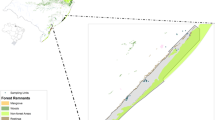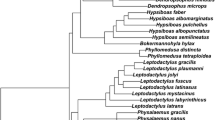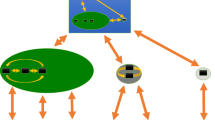Abstract
Evaluating beta diversity patterns along environmental gradients and different geographic ranges helps comprehend the roles of niche-based and spatial processes to metacommunity structure. Pond-breeding anuran composition depends on environmental predictors such as climate, vegetation type and habitat features as well as spatial processes (e.g., dispersal limitation or distances among patches). Here, we investigated the role of spatial and local (water chemistry and habitat structure) and regional (climate) environmental predictors to tadpole beta diversity (and its turnover and nestedness-resultant components) in temporary ponds distributed along a forest–grassland transition in the southern Brazilian Coastal Plain. Additionally, we investigated the role of the assessed predictors within forest and grassland sub-regions to test for congruence in their contribution across vegetation types. Turnover was the most relevant component of beta diversity. Spatial predictors alone explained beta diversity (and both components) at the broadest scale. However, the contribution of environmental and spatial predictors to beta diversity differed between sub-regions. Spatial and local environmental predictors independently explained beta diversity in the grassland, while in the forest sub-region, local predictors and spatially-structured climate were the most important. Our results revealed a complex interplay of niche-based and spatial assembly processes shaping anuran metacommunities. The different relationships of environmental and spatial predictors with beta diversity in the forest and grassland sub-regions suggest that the contribution of assembly processes to anuran metacommunity structure change with vegetation type.



Similar content being viewed by others
References
Amburgey S, Funk WC, Murphy M, Muths E (2012) Effects of hydroperiod duration on survival, developmental rate, and size at metamorphosis in boreal chorus frog tadpoles (Pseudacris maculata). Herpetologica 68:456–467. https://doi.org/10.1655/HERPETOLOGICA-D-11-00093
Andrade DV, Bevier CR, Carvalho JE (2017) Amphibian and reptile adaptations to the environment: interplay between physiology and behavior. CRC Press, Boca Raton
Angeler DG (2013) Revealing a conservation challenge through partitioned long-term beta diversity: increasing turnover and decreasing nestedness of boreal lake metacommunities. Divers Distrib 19:772–781. https://doi.org/10.1111/ddi.12029
Babbitt KJ, Baber MJ, Tarr TL (2003) Patterns of larval amphibian distribution along a wetland hydroperiod gradient. Can J Zool 81:1539–1552. https://doi.org/10.1139/z03-131
Babini S, Martina LC, Luque E et al (2017) Anuran larvae diet from agroecosystem’s ponds: environmental quality and implications for their populations. J Limnol 76:137–147. https://doi.org/10.4081/jlimnol.2016.1455
Baselga A (2012) The relationship between species replacement, dissimilarity derived from nestedness, and nestedness. Glob Ecol Biogeogr 21:1223–1232. https://doi.org/10.1111/j.1466-8238.2011.00756.x
Blanchet G, Legendre P, Borcard D (2008) Forward selection of spatial explanatory variables. Ecology 89:2623–2632. https://doi.org/10.1890/07-0986.1
Borcard D, Legendre P (2012) Is the Mantel correlogram powerful enough to be useful in ecological analysis? A simulation study. Ecology 93:1473–1481. https://doi.org/10.1890/11-1737.1
Borcard D, Legendre P, Avois-Jacquet C, Tuomisto H (2011) Dissecting the spatial structure of ecological data at multiple scales. Ecology 85:1826–1832. https://doi.org/10.1890/03-3111
Both C, Solé M, Dos Santos TG, Cechin SZ (2009) The role of spatial and temporal descriptors for neotropical tadpole communities in southern Brazil. Hydrobiologia 624:125–138. https://doi.org/10.1007/s10750-008-9685-5
Both C, Cechin SZ, Melo AS, Hartz SM (2011) What controls tadpole richness and guild composition in ponds in subtropical grasslands? Austral Ecol 36:530–536. https://doi.org/10.1111/j.1442-9993.2010.02183.x
Brown BL, Sokol ER, Skelton J, Tornwall B (2017) Making sense of metacommunities: dispelling the mythology of a metacommunity typology. Oecologia 183:643–652. https://doi.org/10.1007/s00442-016-3792-1
Carvalho JC, Cardoso P, Borges PAV et al (2013) Measuring fractions of beta diversity and their relationships to nestedness: a theoretical and empirical comparison of novel approaches. Oikos 122:825–834
Chase JM, Myers JA (2011) Disentangling the importance of ecological niches from stochastic processes across scales. Philos Trans R Soc B Biol Sci 366:2351–2363. https://doi.org/10.1098/rstb.2011.0063
Cottenie K (2005) Integrating environmental and spatial processes in ecological community dynamics. Ecol Lett 8:1175–1182. https://doi.org/10.1111/j.1461-0248.2005.00820.x
Couto AP, Ferreira E, Torres RT, Fonseca C (2017) Local and landscape drivers of pond-breeding amphibian diversity at the northern edge of the Mediterranean. Herpetologica 73:10–17. https://doi.org/10.1655/HERPETOLOGICA-D-16-00020.1
De Bie T, De Meester L, Brendonck L et al (2012) Body size and dispersal mode as key traits determining metacommunity structure of aquatic organisms. Ecol Lett 15:740–747. https://doi.org/10.1111/j.1461-0248.2012.01794.x
Declerck SAJ, Coronel JS, Legendre P, Brendonck L (2011) Scale dependency of processes structuring metacommunities of cladocerans in temporary pools of High-Andes wetlands. Ecography (Cop) 34:296–305. https://doi.org/10.1111/j.1600-0587.2010.06462.x
Dray S, Bauman D, Blanchet G, Borcard D, Clappe S, Guenard G, Jombart T, Larocque G, Legendre P, Madi N, Wagner HH (2019) Package ‘adespatial: multivariate multiscale spatial analysis.’ R package version 0.3-7
Godinho MBC, Silva FR (2018) The influence of riverine barriers, climate, and topography on the biogeographic regionalization of Amazonian anurans. Sci Rep 8:3427. https://doi.org/10.1038/s41598-018-21879-9
Guerry AD, Hunter ML (2002) Amphibian distributions in a landscape of forests and agriculture: an examination of landscape composition and configuration. Conserv Biol 16:745–754. https://doi.org/10.1046/j.1523-1739.2002.00557.x
Hecnar SJ, MCloskey RT (1997) Patterns of nestedness and species association in a pond-dwelling amphibian fauna patterns of nestedness and species association in a pond-dwelling amphibian fauna. Oikos 80:371–381. https://doi.org/10.2307/3546605
Heino J (2013) Does dispersal ability affect the relative importance of environmental control and spatial structuring of littoral macroinvertebrate communities? Oecologia 171:971–980. https://doi.org/10.1007/s00442-012-2451-4
Heino J, Melo AS, Siqueira T et al (2015) Metacommunity organisation, spatial extent and dispersal in aquatic systems: patterns, processes and prospects. Freshw Biol 60:845–869. https://doi.org/10.1111/fwb.12533
Hijmans RJ, Cameron SE, Parra JL et al (2005) Very high resolution interpolated climate surfaces for global land areas. Int J Climatol 25:1965–1978. https://doi.org/10.1002/joc.1276
Holyoak M, Leibold MA, Holt RD (2005) Metacommunities: spatial dynamics and ecological communities. University of Chicago Press, Chicago
IBGE (2004) Mapa de Biomas do Brasil. Primeira Aproximação. Escala 1:5.000.000. http://www.terrabrasilis.org.br/ecotecadigital/index.php/estantes/mapas/563-mapa-de-biomas-do-brasil
Jeffries M (2005) Small ponds and big landscapes: the challenge of invertebrate spatial and temporal dynamics for European pond conservation. Aquat Conserv Mar Freshw Ecosyst 15:541–547
Júnior VNTB, Rocha CFD (2013) Tropical tadpole assemblages: which factors affect their structure and distribution? Oecol Aust 17:217–228. https://doi.org/10.4257/oeco.2013.1702.04
Knauth DS, Felipe L, Moreira B, Maltchik L (2018) Partitioning tadpole beta diversity in highland ponds with different hydroperiods. Freshw Sci 37:380–388. https://doi.org/10.1086/697926
Landeiro VL, Waldez F, Menin M (2014) Spatial and environmental patterns of Amazonian anurans: differences between assemblages with aquatic and terrestrial reproduction, and implications for conservation management. Nat Conserv 12:42–46. https://doi.org/10.4322/natcon.2014.008
Lawler JJ, Shafer SL, Bancroft BA, Blaustein AR (2010) Projected climate impacts for the amphibians of the Western Hemisphere. Conserv Biol 24:38–50
Leão TCC, Fonseca CR, Peres CA, Tabarelli M (2014) Predicting extinction risk of Brazilian Atlantic Forest angiosperms. Conserv Biol 28:1349–1359. https://doi.org/10.1111/cobi.12286
Leão-Pires TA, Luiz AM, Sawaya RJ (2018) The complex roles of space and environment in structuring functional, taxonomic and phylogenetic beta diversity of frogs in the Atlantic Forest. PLoS One. https://doi.org/10.1371/journal.pone.0196066
Legendre P (2014) Interpreting the replacement and richness difference components of beta diversity. Glob Ecol Biogeogr 23:1324–1334. https://doi.org/10.1111/geb.12207
Legendre P, Anderson MJ (1999) Distance-based redundancy analysis: testing multispecies responses in multifactorial ecological experiments. Ecol Monogr 69:1–24
Legendre P, Legendre LFJ (2012) Numerical ecology, 3rd edn. Elsevier, Amsterdam
Leibold MA, Holyoak M, Mouquet N et al (2004) The metacommunity concept: a framework for multi-scale community ecology. Ecol Lett 7:601–613. https://doi.org/10.1111/j.1461-0248.2004.00608.x
Leprieur F, Tedesco PA, Hugueny B et al (2011) Partitioning global patterns of freshwater fish beta diversity reveals contrasting signatures of past climate changes. Ecol Lett 14:325–334. https://doi.org/10.1111/j.1461-0248.2011.01589.x
Logue JB, Mouquet N, Peter H, Hillebrand H (2011) Empirical approaches to metacommunities: a review and comparison with theory. Trends Ecol Evol 26:482–491. https://doi.org/10.1016/j.tree.2011.04.009
Lucena CAS, Calegari BB, Pereira EHL, Dallegrave E (2013) O uso de óleo de cravo na eutanásia de peixes March 2013. Bol Soc Bras Ictiol 105:20–24
Luiz AM, Leão-Pires TA, Sawaya RJ (2016) Geomorphology drives amphibian beta diversity in Atlantic Forest Lowlands of southeastern Brazil. PLoS One 11:1–16. https://doi.org/10.1371/journal.pone.0153977
Machado IF, Moreira LFB, Maltchik L (2012) Effects of pine invasion on anurans assemblage in southern Brazil coastal ponds. Amphib Reptil 33:227–237. https://doi.org/10.1163/156853812X638518
Maltchik L (2003) Three new wetlands inventories in Brazil. Interciencia 28:421–423
Melchior LG, Rossa-Feres DC, Silva FR (2017) Evaluating multiple spatial scales to understand the distribution of anuran beta diversity in the Brazilian Atlantic Forest. Ecol Evol 7:2403–2413. https://doi.org/10.1002/ece3.2852
Melo M, Fava F, Pinto HB, Nomura F (2014) Are assemblages of aquatic-breeding anurans (Amphibia) niches structured or neutral? Biotropica 46:608–614. https://doi.org/10.1111/btp.12130
Menin M, Waldez F, Lima AP (2011) Effects of environmental and spatial factors on the distribution of anuran species with aquatic reproduction in central Amazonia. Herpetol J 21:255–261
Moreira LFB, Maltchik L (2012) Assessing patterns of nestedness and co-occurrence in coastal pond anuran assemblages. Amphibia-Reptilia 33:261–271. https://doi.org/10.1163/156853812X641721
Moreira LFB, Moura RG, Maltchik L (2016) Stop and ask for directions: factors affecting anuran detection and occupancy in Pampa farmland ponds. Ecol Res 31:65–74. https://doi.org/10.1007/s11284-015-1316-9
Oksanen J, Blanchet FG, Friendly M, Kindt R, Legendre P, McGlinn D, Minchin PR, O'Hara RB, Simpson GL, Solymos P, Stevens MHH, Szoecs E, Wagner H (2019) Package ‘vegan’. Community ecology package, version 2.5-5
Oliveira M, Aver GF, Moreira LFB, Colombo P, Tozetti AM (2016) Daily movement and microhabitat use by the Blacksmith Treefrog Hypsiboas faber (Anura: Hylidae) during the breeding season in a subtemperate forest of Southern Brazil. South Am J Herpetol 11:89–97. https://doi.org/10.2994/sajh-d-16-00017.1
Pellet J, Hoehn S, Perrin N (2004) Multiscale determinants of tree frog (Hyla arborea L.) calling ponds in western Switzerland. Biodivers Conserv 13:2227–2235
Pereira G, Maneyro R (2016) Movement patterns in a Uruguayan population of Melanophryniscus montevidensis (Philippi, 1902) (Anura: bufonidae) using photo-identification for individual recognition. South Am J Herpetol 11:119–126. https://doi.org/10.2994/sajh-d-15-00020.1
Peres-Neto PR, Legendre P, Dray S, Borcard D (2006) Variation partitioning of species data matrices: estimation and comparison of fractions. Ecology 87:2614–2625. https://doi.org/10.1890/0012-9658(2006)87%5b2614:vposdm%5d2.0.co;2
Pintar MR, Resetarits WJ (2018) Variation in pond hydroperiod affects larval growth in Southern Leopard Frogs, Lithobates sphenocephalus. Copeia 106:70–76. https://doi.org/10.1643/CE-17-696
Pires MM, Stenert C, Maltchik L (2018) Drivers of beta diversity of Odonata along a forest–grassland transition in southern Brazilian coastal ponds. Freshw Sci 37:357–366. https://doi.org/10.1086/697925
Pittman SE, Osbourn MS, Semlitsch RD (2014) Movement ecology of amphibians: a missing component for understanding population declines. Biol Conserv 169:44–53
Prado VHM, Rossa-Feres DC (2014a) The influence of niche and neutral processes on a neotropical anuran metacommunity. Austral Ecol 39:540–547. https://doi.org/10.1111/aec.12114
Prado VHM, Rossa-Feres DDC (2014b) Multiple determinants of anuran richness and occurrence in an agricultural region in south-eastern Brazil. Environ Manage 53:823–837. https://doi.org/10.1007/s00267-014-0241-y
Provete DB, Gonçalves-Souza T, Garey MV et al (2014) Broad-scale spatial patterns of canopy cover and pond morphology affect the structure of a Neotropical amphibian metacommunity. Hydrobiologia 734:69–79
R Core Team (2019) R: a language and environment for statistical computing
Ramalho WP, Machado IF, Vieira LJS (2018) Do flood pulses structure amphibian communities in floodplain environments? Biotropica 50:338–345. https://doi.org/10.1111/btp.12523
Rodrigues DJ, Lima AP, Magnusson WE, Costa FRC (2010) Temporary pond availability and tadpole species composition in central Amazonia. Herpetologica 66:124–130. https://doi.org/10.1655/09-020R2.1
Rojas-Ahumada DP, Landeiro VL, Menin M (2012) Role of environmental and spatial processes in structuring anuran communities across a tropical rain forest. Austral Ecol 37:865–873
Santos TG, Rossa-Feres DC, Casatti L (2007) Diversidade e distribuição espaço-temporal de anuros em região com pronunciada estação seca no sudeste do Brasil. Iheringia Série Zool 1:37–49. https://doi.org/10.1590/S0073-47212007000100007
Semlitsch RD (2008) Differentiating migration and dispersal processes for pond-breeding amphibians. J Wildl Manage 72:260–267
Silva FR, Almeida-Neto M, Arena MVN (2014) Amphibian beta diversity in the Brazilian atlantic forest: contrasting the roles of historical events and contemporary conditions at different spatial scales. PLoS One. https://doi.org/10.1371/journal.pone.0109642
Sinsch U (1990) Migration and orientation in anuran amphibians. Ethol Ecol Evol 2:65–79
Sinsch U (2014) Movement ecology of amphibians: from individual migratory behaviour to spatially structured populations in heterogeneous landscapes. Can J Zool 92:491–502. https://doi.org/10.1139/cjz-2013-0028
Smith MA, Green D (2005) Dispersal and the metapopulation paradigm in amphibian ecology and conservation: Are all amphibian populationsmetapopulations? Ecography 28:110–128. https://doi.org/10.1111/j.0906-7590.2005.04042.x
Socolar JB, Gilroy JJ, Kunin WE, Edwards DP (2016) How should beta-diversity inform biodiversity conservation? Conservation targets at multiple spatial scales. Trends Ecol Evol 31:67–80. https://doi.org/10.1016/j.tree.2015.11.005
Soininen J (2014) A quantitative analysis of species sorting across organisms and ecosystems. Ecology 95:3284–3292
Soininen J, McDonald R, Hillebrand H (2007) The distance decay of similarity in ecological communities. Ecography (Cop) 30:3–12. https://doi.org/10.1111/j.2006.0906-7590.04817.x
Stebbins RC, Cohen NW (1995) Declining amphibians. A natural history of amphibians. Princeton University Press, Princeton, pp 210–251
Ultsch GR, Bradford DF, Freda J (1999) Physiology: coping with the environment. In: McDiarmid R, Altig R (eds) The biology of anuran larvae. The University of Chicago Press, Tadpoles, pp 189–214
Valério LM, Dorado-Rodrigues TF, Chupel TF et al (2016) Vegetation structure and hydroperiod affect anuran composition in a large Neotropical wetland. Herpetologica 72:181–188. https://doi.org/10.1655/Herpetologica-D-14-00069.1
Vasconcelos TS, Santos TG, Rossa-Feres DC, Haddad CF (2009) Influence of the environmental heterogeneity of breeding ponds on anuran assemblages from southeastern Brazil. Can J Zool 87:699–707. https://doi.org/10.1139/Z09-058
Vasconcelos TS, Prado VHM, Silva FR, Haddad CFB (2014) Biogeographic distribution patterns and their correlates in the diverse frog fauna of the atlantic forest hotspot. PLoS One 9:1–9. https://doi.org/10.1371/journal.pone.0104130
Villwock JA, Tomazelli LJ (2006) Planície Costeira do Rio Grande do Sul: gênese e paisagem atual. In: Becker FG, Ramos RA, Moura LA (eds) Biodiversidade. Regiões da Lagoa do Casamento e dos Butiazais de Tapes, planície costeira do Rio Grande do Sul. Ministério do Meio Ambiente, Brasília, pp 20–33
Ward JV, Tockner K, Schiemer F (1999) Biodiversity of floodplain river ecosystems: ecotones and connectivity. River Res Appl 15:125–139
Wells KD (2007) The ecology and behavior of amphibians. The University of Chicago Press, Chicago
Werner EE, Skelly DK, Relyea RA, Yurewicz KL (2007) Amphibian species richness across environmental gradients. Oikos 116:1697–1712. https://doi.org/10.1111/j.0030-1299.2007.15935.x
Whittaker RH (1960) Vegetation of the Siskiyou Mountains, Oregon and California. Ecol Monogr 30:279–338
Whittaker RH (1972) Evolution and measurement of species diversity. Taxon 21:213–251
Wilbur HM (1987) Regulation of structure in complex systems: experimental temporary pond communities. Ecology 68:1437–1452
Williams DD (2006) The biology of temporary waters. Oxford University Press, New York
Winegardner AK, Jones BK, Ng ISY et al (2012) The terminology of metacommunity ecology. Trends Ecol Evol 27:253–254. https://doi.org/10.1016/j.tree.2012.01.007
Acknowledgements
This study was part of DSK Master course dissertation at the Biology Graduate Program from UNISINOS University. This research was funded by CNPq (Brazilian National Council for Scientific and Technological Development), as part of the project entitled ‘Effects of climate change on wetland biodiversity in southern Brazil: A space-time approach’ (Grant number 474892/2013-1). CAPES (Coordination for the Improvement of Higher Education Personnel) granted a Master scholarship to DSK. CNPq granted a postdoctoral research fellowship to MMP at the Biology Graduate Program from UNISINOS University (Grant number 151152/2018-7). LM and CS have been continuously funded by CNPq via Research Productivity grants.
Author information
Authors and Affiliations
Contributions
DSK collected and conducted the specimen identification and participated in the drafting of the manuscript. MMP analyzed the data and drafted the manuscript. LM and CS conceived the project and coordinated several aspects of the study, including revision of the manuscript. All authors read and approved the final version of the manuscript.
Corresponding author
Ethics declarations
Conflict of interest
The authors declare no conflict of interest.
Ethical approval
We declare that the data collection complied with current Brazilian environmental laws (SISBIO-n. 36365-2).
Additional information
Publisher's Note
Springer Nature remains neutral with regard to jurisdictional claims in published maps and institutional affiliations.
Electronic supplementary material
Below is the link to the electronic supplementary material.
27_2019_658_MOESM1_ESM.tiff
Fig. S1. Graphical outputs of the first two principal components (PC1 and PC2) of the principal component analysis (PCA) of the WorldClim bioclimatic variables for the 24 ponds studied. (A) Plot of the ponds; (B) plot of the correlation (loadings) of the variables. (TIFF 2741 kb)
27_2019_658_MOESM2_ESM.tif
Fig. S2. Conceptual figure summarizing the objectives of the study. (A) The two components of beta diversity (turnover and nestedness/richness; adapted from: Baselga 2012). (B) Sampling design of the study emphasizing the main vegetation types (Pampa and Atlantic Forest) in the study region (Coastal Plain) and the scales of analysis (broad extent and sub-regions). (TIFF 1306 kb)
27_2019_658_MOESM3_ESM.tif
Fig. S3. Step by step representation of the undertaken statistical procedures for the analyses of the relationships between tadpole beta diversity and spatial predictors and environmental drivers. (TIFF 1290 kb)
27_2019_658_MOESM4_ESM.tiff
Fig. S4. Graphic outputs of the multivariate Mantel correlograms used for the testing of spatial autocorrelation in each dataset (Coastal Plain, Atlantic Forest and Pampa subsets). (TIFF 1129 kb)
Rights and permissions
About this article
Cite this article
Knauth, D.S., Pires, M.M., Stenert, C. et al. Disentangling the role of niche-based and spatial processes on anuran beta diversity in temporary ponds along a forest–grassland transition. Aquat Sci 81, 63 (2019). https://doi.org/10.1007/s00027-019-0658-8
Received:
Accepted:
Published:
DOI: https://doi.org/10.1007/s00027-019-0658-8




